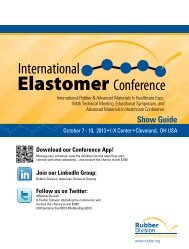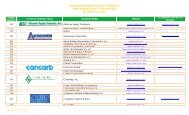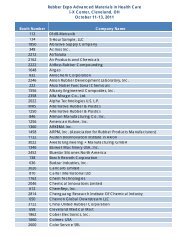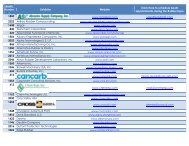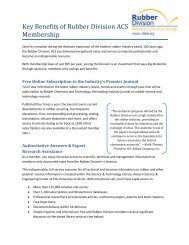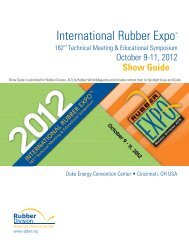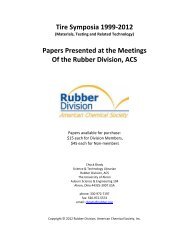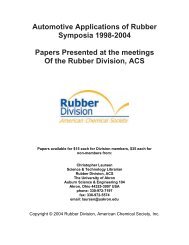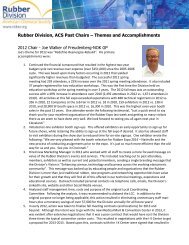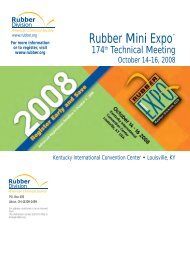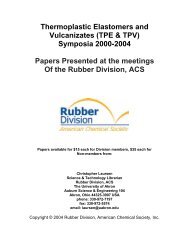Training Directory - Rubber Division
Training Directory - Rubber Division
Training Directory - Rubber Division
Create successful ePaper yourself
Turn your PDF publications into a flip-book with our unique Google optimized e-Paper software.
MANUFACTURING & PROCESSING<br />
Engineering with <strong>Rubber</strong><br />
7 hours<br />
CEUs: .7<br />
This course is specifi cally prepared for engineers who are not<br />
especially familiar with elastomers and their engineering<br />
properties. The basics of elastomer chemistry and processing<br />
will be presented, after which a more detailed examination<br />
of engineering properties and the behavior of elastomers in<br />
engineering applications will be examined. The goal of the<br />
instruction is to fi rst help engineers understand the underlying<br />
chemistry and processing of elastomers. Second, to learn what<br />
kind of engineering properties characterize elastomers and how<br />
those properties may be best utilized in engineering applications.<br />
Silicone Basics<br />
4 hours<br />
CEUs: .4<br />
This course will cover the following topics:<br />
• Silicone Characteristics and Benefi ts<br />
• Different Types (focus primarily on VMQ,<br />
not fl uro or phenyl)<br />
• How it is Made<br />
• Why it is Different Than Other Materials<br />
• Curing<br />
• Silica Powders<br />
• Additives for Different Properties and Applications<br />
• HCR Processing<br />
• LSR Differences – Properties and Processing<br />
• Q&A<br />
Introduction to Dispersions<br />
4 hours<br />
CEUs: .4<br />
This course will start with a detailed explanation about how<br />
dispersion is accomplished in rubber, including both liquids and<br />
solids. Next, each type of dispersion will be studied, including<br />
the common carriers and their capabilities. When discussing the<br />
polymer bound dispersion, several polymer types and combination<br />
will be examined. Finally, each type of dispersion will be explored<br />
as to their benefi ts and limitations.<br />
Internal Mixers and Mixing<br />
Parameters<br />
6 hours<br />
CEUs: .6<br />
This presentation covers a number of topics dealing with Internal<br />
Mixers and Mixing Parameters (the things that affect rubber mixing).<br />
It starts off with a brief history of mixing equipment, goes into<br />
what an internal mixer is and some of its different options. It<br />
covers the different types of rotors and how they differ, then<br />
spends a great deal of time looking into the infl uence of various<br />
mechanical and non-mechanical parameters and the effects they<br />
have on rubber mixing, production uniformity, wear and damage,<br />
the mixing process. It fi nishes with actual examples of problems<br />
encountered in the fi eld, what caused them and how they were<br />
resolved.<br />
Introduction to <strong>Rubber</strong> Technology<br />
for Non-Technologists<br />
Webinar<br />
If you are new to the industry, working in Engineering, Sales,<br />
Administration, Human Resources or any other non-technical<br />
area, and you’d like a very basic, easy to understand introduction<br />
to the jargon of the trade and what goes on in the factory and lab,<br />
then this 60-minute webinar is perfect for you. You won’t come<br />
out a rubber expert, but you will understand all the basics of the<br />
technology and the language of the business.<br />
8 RUBBER DIVISON, ACS EDUCATION OPPORTUNITIES



